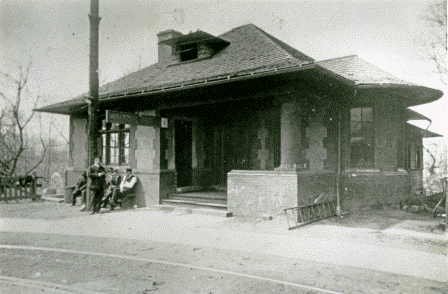The Chevy Chase Trolley station that moved to the country

Waiting Room and Office, Rock Creek Railway, Chevy Chase Lake, designed by Lindley Johnson. Photo from a 1914 report, Capital Traction Company. From a slide donated by Robert Truax to the Chevy Chase Historical Society. CCHS 2008.144.05.
When the Chevy Chase Land Company started developing land north of Rock Creek Park in 1890, it built a streetcar to connect to Washington, DC. That streetcar line ended at Chevy Chase Lake on Connecticut Avenue, just south of the Georgetown Branch, where a small building on the west side served as a waiting station and office.
The Chevy Chase Lake waiting station stood on land between Coquelin Run and what is today Parkway Dry Cleaners for at least 80 years, the last 20 as an abandoned structure. In 1980, to preserve it, it was disassembled and moved to Hyattstown, Maryland where it still sits today.
The trolly connected Chevy Chase to Kensington in its heyday
The trolley to Chevy Chase Lake started running in 1892 as the Rock Creek Railway, and it stopped just south of the Georgetown Branch rail line. There they built a turnaround and, on the east side of Connecticut Avenue, a car barn and a lake to provide power for the streetcar. The trolley waiting room was built around that time, but it was originally a home and then a store before the Chevy Chase Lake land company started using it.
The Rock Creek Railway eventually expanded to form the Capital Traction Company and ran trolleys all the way to Kensignton. But in 1935, Capital Traction was given permission to replace the streetcar with buses, which they did on September 15 that same year. The trolley poles, safety domes, and other waiting stations — which were more like bus stop shelters — were all removed over the following week.
The tracks were removed in 1940 when they became valuable as scrap metal (a loophole in the Export Control Act didn’t include tracks as a type of scrap metal barred for sale). They were sold to Japan, likely for the construction of armaments during the buildup to World War II.
Despite the end of the streetcar, the waiting room endured
It’s not clear what the waiting room was used for after the trolley stopped running, but it’s possible it was affiliated with the swimming pool that was built behind it in 1925. The pool was leased to the Chevy Chase Lake Swim Club until 1972.
That year was the last season for the pool, not because the swim club — the oldest in Montgomery County at the time — was unpopular, but because the Land Company planned to build a 16-story luxury apartment complex on the land. (It never did, but it filled in the pool anyway.)
By 1980, the waiting room was the last remaining trolley car station in Montgomery County but it had been left to decay for nearly 20 years. Then the building was deemed historic and thus became something of a white elephant for the Land Company. When local historian and dog kennel owner Edward Knowles and the Friends of Historic Hyattstown offered to move it, the Land Company took their offer.
The land company paid $75,000 to move it to Hyattstown where Knowles attached it to the then 120-year-old Thistle Hill Cottage, formerly the Price’s Distillery Office, which he happened to own. Knowles paid the other $30,000. Friends of Historic Hyattstown helped with some of the labor in exchange for being allowed to use the building for meetings.
In the summer of 1980, the building was dismantled brick by brick and moved to its new home in Frederick County.
The Chevy Chase trolly waiting room in its current resting place, attached to the Thistle Hill Cottage. Image created with Google Maps. 
What goes around…
Knowles said he wanted to move the waiting room and attach it to Thistle Hill Cottage in the hope of saving both buildings, and it appears he succeeded. The waiting room can now be seen on Price’s Distillary Road just east of Green Valley Road in Hyattstown (some might call it Clarksburg), attached to the cottage.
In the google streetview above, you can make out the column and front window from the image above. From the aerial view, you can just make out the curved portion of the roof. The building is now painted, faces west instead of east, and its chimney had to be rebuilt to conform with fire codes. Otherwise, it looks largely the same.
It’s great that this piece of Maryland history could be saved, and, like the titular character of Virginia Lee Burton’s “The Little House,” moved to a setting similar to the one it was originally constructed in. But if it could have just waited for 40 years, the trolley — this time traveling east and west — would’ve come back to it.
